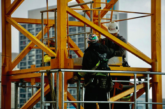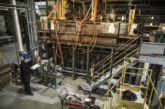
The Government’s £5bn funding for cladding remediation works is nowhere near enough for what is required to make every high-rise housing development EWS1 A1 compliant, according to a leading contractor and cladding remediation expert which has been pricing jobs across the country.
Colmore Tang Construction has priced remedial projects on over 20 typical developments in Leeds, Liverpool, Manchester and The Midlands in the last few months and their analysis suggests a total figure closer to £50bn, which equates to approximately one third of the annual output for the whole construction industry.
Based in the Midlands, Colmore Tang has delivered over 3,500 high density residential units and has years of experience in whole building remediation, which includes cladding and envelope remedial works. They launched a cladding remediation arm in January 2021 in light of the ongoing crisis.
Colmore Tang has actively priced the works on over 20 typical developments that have been investigated and found to be defective, therefore requiring envelope remedial works if they are to meet the EWS1 compliancy criteria. They have found the average cost of these works to be circa £4.65m for buildings above 18m and circa £2m for buildings between 11m and 18m, which they claim is fair reflection of typical costs across the country.
The latest Building Safety Programme figures from MHCLG reveal that around 5,000 buildings over 18m require an EWS1 certificate and may require remedial works, while the same can be said for around 35,000 11-18m buildings. According to Colmore Tang’s pricing, which reflects their first-hand and recent experience of tender processes for cladding remedial works, this would bring the total to around £25bn for buildings over 18m and £70bn for buildings between 11m and 18m.
Given the paucity of information generally available and taking an optimistic view, they have reduced the theoretical total of £95bn by around half for safe measure, arriving at almost £50bn + VAT as a realistic upper sum.
Building Safety Fund
There has been mounting pressure from MPs to reassess the size of the Building Safety Fund, with the Housing, Communities and Local Government committee claiming the full cost of remedial works could be closer to £15bn.
Revisions from industry experts and political representatives have put question marks over the government’s arrival at £5bn as a realistic budget, which also fails to account for the irrecoverable 20% VAT and which Colmore Tang believes will ultimately be borne by the unfortunate occupiers.
The contractor’s evidence suggests that the initial costing methodology from professionals submitting bids to the Building Safety Fund did not accurately reflect the full scope of works. Colmore Tang claims that initial bid submissions do not fully account for many logistical challenges, permits, rising costs of materials and scarcity of resources.
Their conversations with developers throughout the UK, as well as their engagement in tendering processes, have revealed that some professionals have submitted budgets which are as much as three to four times below the real cost of the works. They cite a recent example of a developer in Birmingham, which submitted a bid for £3m despite the full project being worth closer to £10m, and claims it is a phenomenon being repeated across the country.
Some remedial works will need to be carried out within the building itself, for example, leading to significant costs associated with the temporary accommodation of residents. Commercial facilities would also need to be closed if the structural works of those premises are affected.
Basic Asset Protection Agreements
Another example is the formulation of Basic Asset Protection Agreements, permits for which developers must apply in the event of any construction works taking place beside Network Rail Infrastructure. They can often take up to 9 months to secure, carrying with it significant fees for those involved in the project in the meantime.
Developers could also face unlimited fines if they fail to adequately protect water courses located in and around their site and the inspection of these routes alone can add tens of thousands to the cost of a project.
Steve Underwood, Chief Operating Officer of Colmore Tang, commented: “The bottom line is that the true cost of remedial works has been severely underestimated and meaningful progress won’t be made until politicians and industry professionals develop a clearer understanding of funding and logistical challenges at hand here.
“Our estimates are not plucked out of thin air but are based upon real life scenarios, which we see day in, day out. There’s a stark difference between costing a project and actually executing it, which largely explains this discrepancy. We’re seeing developers and surveyors quoting budgets that are nowhere near where they should be and we’re sleep walking into a scenario in which that only becomes apparent half way through the remedial works. That’s bad news for everyone.
“Suggestions that by simply re-tendering schemes we can reduce costs to original figures are patently unrealistic and quite frankly, dangerous. The race to the bottom approach to costing produced the poor workmanship, material standards and quality control, which led to the cladding crisis in the first place and we are in danger of things spiralling out of control if we don’t buck up our ideas. That needs to be driven by contractors, developers and surveyors and supported by a government prepared to dip into its pockets.”
Insurance
Steve continued: “Another of the Government’s urgent priorities will be to address the insurance dilemma, which has gone under the radar despite it being one of the most onerous stumbling blocks in this crisis. Suggestions that a building may be made safe by the incorporation of additional fire barriers to a B1 standard is all well and good and may be significantly cheaper, but as things stand any designers, fire engineers, insurers or contractors worth their salt wouldn’t risk this approach. They’re inevitably and understandably unwilling to carry that risk. Indeed, it is almost impossible to procure Professional Indemnity Insurance at commercial realistic rates. As a consequence we could be in a position where the country will be flooded with uninsurable buildings.
“Insurance providers need to be able to offer Professional Indemnity Insurance at commercially attractive rates, to enable this insurances may have to be underwritten by Government. That, combined with risk based analysis on affected buildings, the removal of VAT on the works, fast track training and development for specialist designers and fire engineers, are the first steps we need to be take.
“Whilst ensuring that the essential cladding repairs are undertaken, cognisance must be given to the other elephants in the room, namely maintenance of life safety systems and the remediation of internal fire compartmentation. It is noteworthy that these matters have been addressed under the provisions of the Act but do not appear to be part of the Fund.”
Header image ©thinglass/AdobeStock








